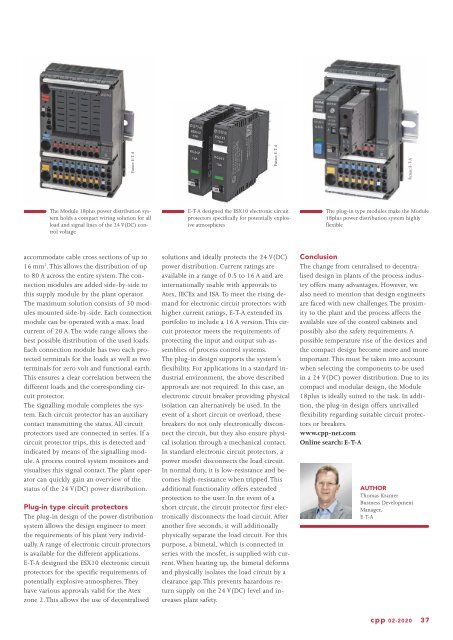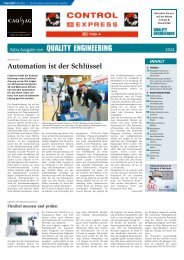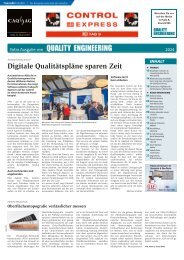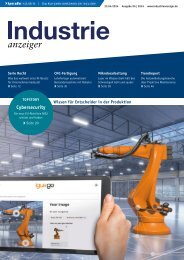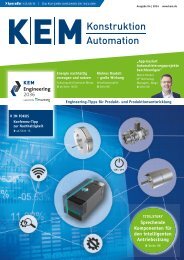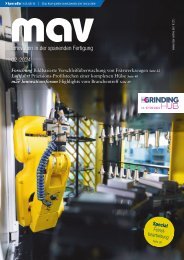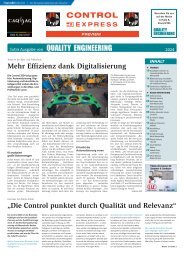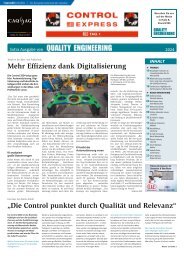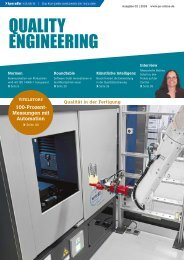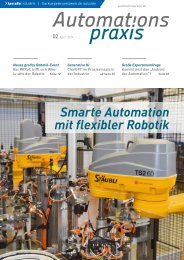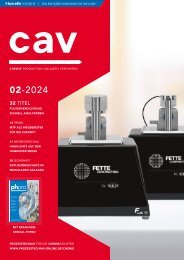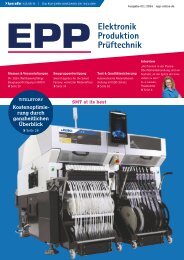cpp – Process technology for the chemical industry 02.2020
The journal cpp - Process technology for the chemical industry reports about processes, plants, apparatus and components for the chemical and pharmaceutical industry. Further topics are IT technologies, industry 4.0, digital production, MSR and automation technology and process analysis technology. The content spectrum is rounded off by explosion protection, plant safety, occupational health and safety, maintenance, site management and energy management.
The journal cpp - Process technology for the chemical industry reports about processes, plants, apparatus and components for the chemical and pharmaceutical industry. Further topics are IT technologies, industry 4.0, digital production, MSR and automation technology and process analysis technology. The content spectrum is rounded off by explosion protection, plant safety, occupational health and safety, maintenance, site management and energy management.
You also want an ePaper? Increase the reach of your titles
YUMPU automatically turns print PDFs into web optimized ePapers that Google loves.
Picture: E-T-A<br />
Picture: E-T-A<br />
Picture: E-T-A<br />
The Module 18plus power distribution system<br />
holds a compact wiring solution <strong>for</strong> all<br />
load and signal lines of <strong>the</strong> 24 V(DC) control<br />
voltage<br />
E-T-A designed <strong>the</strong> ESX10 electronic circuit<br />
protectors specifically <strong>for</strong> potentially explosive<br />
atmospheres<br />
The plug-in type modules make <strong>the</strong> Module<br />
18plus power distribution system highly<br />
flexible<br />
accommodate cable cross sections of up to<br />
16 mm 2 . This allows <strong>the</strong> distribution of up<br />
to 80 A across <strong>the</strong> entire system. The connection<br />
modules are added side-by-side to<br />
this supply module by <strong>the</strong> plant operator.<br />
The maximum solution consists of 30 modules<br />
mounted side-by-side. Each connection<br />
module can be operated with a max. load<br />
current of 20 A. The wide range allows <strong>the</strong><br />
best possible distribution of <strong>the</strong> used loads.<br />
Each connection module has two each protected<br />
terminals <strong>for</strong> <strong>the</strong> loads as well as two<br />
terminals <strong>for</strong> zero volt and functional earth.<br />
This ensures a clear correlation between <strong>the</strong><br />
different loads and <strong>the</strong> corresponding circuit<br />
protector.<br />
The signalling module completes <strong>the</strong> system.<br />
Each circuit protector has an auxiliary<br />
contact transmitting <strong>the</strong> status. All circuit<br />
protectors used are connected in series. If a<br />
circuit protector trips, this is detected and<br />
indicated by means of <strong>the</strong> signalling module.<br />
A process control system monitors and<br />
visualises this signal contact. The plant operator<br />
can quickly gain an overview of <strong>the</strong><br />
status of <strong>the</strong> 24 V(DC) power distribution.<br />
Plug-in type circuit protectors<br />
The plug-in design of <strong>the</strong> power distribution<br />
system allows <strong>the</strong> design engineer to meet<br />
<strong>the</strong> requirements of his plant very individually.<br />
A range of electronic circuit protectors<br />
is available <strong>for</strong> <strong>the</strong> different applications.<br />
E-T-A designed <strong>the</strong> ESX10 electronic circuit<br />
protectors <strong>for</strong> <strong>the</strong> specific requirements of<br />
potentially explosive atmospheres. They<br />
have various approvals valid <strong>for</strong> <strong>the</strong> Atex<br />
zone 2. This allows <strong>the</strong> use of decentralised<br />
solutions and ideally protects <strong>the</strong> 24 V(DC)<br />
power distribution. Current ratings are<br />
available in a range of 0.5 to 16 A and are<br />
internationally usable with approvals to<br />
Atex, IECEx and ISA. To meet <strong>the</strong> rising demand<br />
<strong>for</strong> electronic circuit protectors with<br />
higher current ratings, E-T-A extended its<br />
portfolio to include a 16 A version. This circuit<br />
protector meets <strong>the</strong> requirements of<br />
protecting <strong>the</strong> input and output sub-assemblies<br />
of process control systems.<br />
The plug-in design supports <strong>the</strong> system’s<br />
flexibility. For applications in a standard industrial<br />
environment, <strong>the</strong> above described<br />
approvals are not required. In this case, an<br />
electronic circuit breaker providing physical<br />
isolation can alternatively be used. In <strong>the</strong><br />
event of a short circuit or overload, <strong>the</strong>se<br />
breakers do not only electronically disconnect<br />
<strong>the</strong> circuit, but <strong>the</strong>y also ensure physical<br />
isolation through a mechanical contact.<br />
In standard electronic circuit protectors, a<br />
power mosfet disconnects <strong>the</strong> load circuit.<br />
In normal duty, it is low-resistance and becomes<br />
high-resistance when tripped. This<br />
additional functionality offers extended<br />
protection to <strong>the</strong> user. In <strong>the</strong> event of a<br />
short circuit, <strong>the</strong> circuit protector first electronically<br />
disconnects <strong>the</strong> load circuit. After<br />
ano<strong>the</strong>r five seconds, it will additionally<br />
physically separate <strong>the</strong> load circuit. For this<br />
purpose, a bimetal, which is connected in<br />
series with <strong>the</strong> mosfet, is supplied with current.<br />
When heating up, <strong>the</strong> bimetal de<strong>for</strong>ms<br />
and physically isolates <strong>the</strong> load circuit by a<br />
clearance gap. This prevents hazardous return<br />
supply on <strong>the</strong> 24 V(DC) level and increases<br />
plant safety.<br />
Conclusion<br />
The change from centralised to decentralised<br />
design in plants of <strong>the</strong> process <strong>industry</strong><br />
offers many advantages. However, we<br />
also need to mention that design engineers<br />
are faced with new challenges. The proximity<br />
to <strong>the</strong> plant and <strong>the</strong> process affects <strong>the</strong><br />
available size of <strong>the</strong> control cabinets and<br />
possibly also <strong>the</strong> safety requirements. A<br />
possible temperature rise of <strong>the</strong> devices and<br />
<strong>the</strong> compact design become more and more<br />
important. This must be taken into account<br />
when selecting <strong>the</strong> components to be used<br />
in a 24 V(DC) power distribution. Due to its<br />
compact and modular design, <strong>the</strong> Module<br />
18plus is ideally suited to <strong>the</strong> task. In addition,<br />
<strong>the</strong> plug-in design offers unrivalled<br />
flexibility regarding suitable circuit protectors<br />
or breakers.<br />
www.<strong>cpp</strong>-net.com<br />
Online search: E-T-A<br />
AUTHOR:<br />
Thomas Kramer<br />
Business Development<br />
Manager,<br />
E-T-A<br />
<strong>cpp</strong> 02-2020 37


